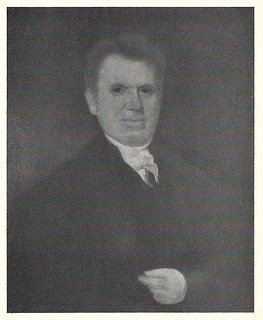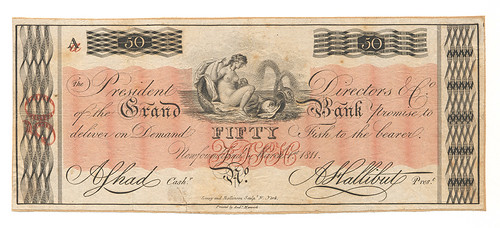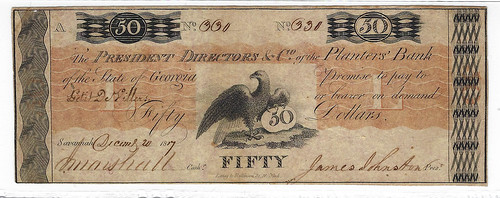
PREV ARTICLE
NEXT ARTICLE
FULL ISSUE
PREV FULL ISSUE
BANKNOTE ENGRAVER WILLIAM ROLLINSONDavid Gladfelter published a guest post on the American Numismatic Society Pocket Change blog about banknote engraver William Rollinson. Here's an excerpt. See the complete article online for more. -Editor
Their monograph tells of the engraver's coming to New York in 1789, finding work in the shops of various silversmiths, and soon turning to copper-plate engraving which occupied him for the rest of his life. At the end appears a sampling of 18 of Rollinson's engravings—calligraphic, ornamental, glyphic and scenic—plus a printed circular which Rollinson had sent to various banks in 1811, soliciting orders for bank notes produced by a ruling machine he had invented. Several of these exhibits came from the personal collection of Charles Rollinson, but the source of the circular was the collection of the New York Public Library.
Next came Robert A. Vlack's short-titled Catalogue of Early North American Advertising Notes in 2001. Item 4640 in the catalog is a specimen bank note dated March 1, 1811 with the imprint
An unlisted variety of Vlack 4640 has a waved-line pink tint (fig. 4) similar to the tint appearing on the Middle District Bank note. It didn't take long for me to identify this specimen variety as the
Rollinson evidently sent his circular and specimen far and wide. Among the respondents was the newly chartered Planters' Bank of the State of Georgia, which ordered notes in seven denominations ranging from $1.00 to $100.00, listed in Haxby as GA-320 G2, G12, G22, G32, G42, G52 and G62, all designated as
But the best was yet to come. A copy of Rollinson's circular appeared in Heritage's October 20, 2020 auction (lot 83078). This circular is printed on bond paper with a faint powder horn watermark. Rollinson's signature is manually written, not printed. As for its provenance, all we know is what Dustin Johnston, Heritage's cataloguer, can tell us: That it was discovered by a book dealer on the East Coast who consigned it to the auction.
To read the complete article, see:
THE BOOK BAZARREWayne Homren, Editor The Numismatic Bibliomania Society is a non-profit organization promoting numismatic literature. See our web site at coinbooks.org. To submit items for publication in The E-Sylum, write to the Editor at this address: whomren@gmail.com To subscribe go to: https://my.binhost.com/lists/listinfo/esylum All Rights Reserved. NBS Home Page Contact the NBS webmaster 
|


